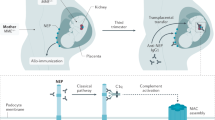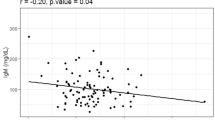Abstract
Optimum treatment of idiopathic membranous nephropathy is both controversial and challenging. The most extensively studied and frequently used immunosuppressive regimens for this disease comprise alkylating agents plus corticosteroids or ciclosporin. All of these treatment options have inherent problems: they are not effective in all patients, partial—rather than complete—remissions are common, adverse effects are worrisome, and relapses after treatment cessation remain problematic. Alternative immunosuppressive agents have been tested in an effort to overcome these unresolved issues. This paper reviews the available evidence regarding both established and new agents for the treatment of patients with idiopathic membranous nephropathy, with an emphasis on the results of the most recent clinical trials.
Key Points
-
Patients with idiopathic membranous nephropathy (IMN) who have a low risk of progression to end-stage renal disease are not usually treated with immunosuppressants
-
The criteria for immunosuppressive treatment in patients with the nephrotic syndrome who have stable, preserved renal function are debated
-
For patients with IMN who are at medium or high risk of disease progression, the most extensively studied immunosuppressive regimens comprise ciclosporin or cytotoxic agents, in combination with steroids
-
Relapses of the nephrotic syndrome after cessation of treatment are a common problem in IMN
-
Favorable experience of the use of rituximab in IMN is growing, but this agent is still considered an experimental therapy at present
-
Adrenocorticotropic hormone and mycophenolate mofetil might have a role in IMN, but evidence is still too limited to make formal recommendations regarding the routine use of these treatments
This is a preview of subscription content, access via your institution
Access options
Subscribe to this journal
Receive 12 print issues and online access
$189.00 per year
only $15.75 per issue
Buy this article
- Purchase on SpringerLink
- Instant access to full article PDF
Prices may be subject to local taxes which are calculated during checkout
Similar content being viewed by others
References
Schena, F. P. Survey of the Italian Registry of Renal Biopsies. Frequency of the renal diseases for 7 consecutive years. The Italian Group of Renal Immunopathology. Nephrol. Dial. Transplant. 12, 418–426 (1997).
Haas, M., Meehan, S. M., Karrison, T. G. & Spargo, B. H. Changing etiologies of unexplained adult nephrotic syndrome: a comparison of renal biopsy findings from 1976–1979 and 1995–1997. Am. J. Kidney Dis. 30, 621–631 (1997).
Glassock, R. J. Secondary membranous glomerulonephritis. Nephrol. Dial. Transplant. 7 (Suppl. 1), 64–71 (1992).
Cattran, D. Management of membranous nephropathy: when and what for treatment. J. Am. Soc. Nephrol. 16, 1188–1194 (2005).
Passerini, P. & Ponticelli, C. Corticosteroids, cyclophosphamide, and chlorambucil therapy of membranous nephropathy. Semin. Nephrol. 23, 355–361 (2003).
du Buf-Vereijken, P. W., Branten, A. J. & Wetzels, J. F. Idiopathic membranous nephropathy: outline and rationale of a treatment strategy. Am. J. Kidney Dis. 46, 1012–1029 (2005).
[No authors listed] A controlled study of short-term prednisone treatment in adults with membranous nephropathy. Collaborative Study of the Adult Idiopathic Nephrotic Syndrome. N. Engl. J. Med. 301, 1301–1306 (1979).
Donadio, J. V. Jr, et al. Idiopathic membranous nephropathy: the natural history of untreated patients. Kidney Int. 33, 708–715 (1988).
Cattran, D. C. et al. A randomized controlled trial of prednisone in patients with idiopathic membranous nephropathy. N. Engl. J. Med. 320, 210–215 (1989).
Cameron, J. S., Healy, M. J. & Adu, D. The Medical Research Council trial of short-term high-dose alternate day prednisolone in idiopathic membranous nephropathy with nephrotic syndrome in adults. The MRC Glomerulonephritis Working Party. Q. J. Med. 74, 133–156 (1990).
Cattran, D. C., Pei, Y. & Greenwood, C. Predicting progression in membranous glomerulonephritis. Nephrol. Dial. Transplant. 7 (Suppl. 1), 48–52 (1992).
Schieppati, A. et al. Prognosis of untreated patients with idiopathic membranous nephropathy. N. Engl. J. Med. 329, 85–89 (1993).
Ponticelli, C. et al. A 10-year follow-up of a randomized study with methylprednisolone and chlorambucil in membranous nephropathy. Kidney Int. 48, 1600–1604 (1995).
Hogan, S. L., Muller, K. E., Jennette, J. C. & Falk, R. J. A review of therapeutic studies of idiopathic membranous glomerulopathy. Am. J. Kidney Dis. 25, 862–875 (1995).
Moranne, O., Watier, L., Rossert, J. & Stengel, B. Primary glomerulonephritis: an update on renal survival and determinants of progression. QJM 101, 215–224 (2008).
Bellomo, R. & Atkins, R. C. Membranous nephropathy and thromboembolism: is prophylactic anticoagulation warranted? Nephron 63, 249–254 (1993).
Ordonez, J. D., Hiatt, R. A., Killebrew, E. J. & Fireman, B. H. The increased risk of coronary heart disease associated with nephrotic syndrome. Kidney Int. 44, 638–642 (1993).
Branten, A. J. et al. Urinary excretion of β2-microglobulin and IgG predict prognosis in idiopathic membranous nephropathy: a validation study. J. Am. Soc. Nephrol. 16, 169–174 (2005).
Bazzi, C. et al. Urinary excretion of IgG and α(1)-microglobulin predicts clinical course better than extent of proteinuria in membranous nephropathy. Am. J. Kidney Dis. 38, 240–248 (2001).
Cattran, D. C. et al. Validation of a predictive model of idiopathic membranous nephropathy: its clinical and research implications. Kidney Int. 51, 901–907 (1997).
Pei, Y., Cattran, D. & Greenwood, C. Predicting chronic renal insufficiency in idiopathic membranous glomerulonephritis. Kidney Int. 42, 960–966 (1992).
Branten, A. J., Reichert, L. J., Koene, R. A. & Wetzels, J. F. Oral cyclophosphamide versus chlorambucil in the treatment of patients with membranous nephropathy and renal insufficiency. QJM 91, 359–366 (1998).
du Buf-Vereijken, P. W., Branten, A. J., Wetzels, J. F. & Membranous Nephropathy Study Group. Cytotoxic therapy for membranous nephropathy and renal insufficiency: improved renal survival but high relapse rate. Nephrol. Dial. Transplant. 19, 1142–1148 (2004).
Hofstra, J. M., Branten, A. J. W. & Wetzels, J. F. M. No benefit of early start of immunosuppressive therapy in idiopathic membranous nephropathy [abstract]. J. Am. Soc. Nephrol. 19, 60A (2008).
Black, D. A., Rose, G. & Brewer, D. B. Controlled trial of prednisone in adult patients with the nephrotic syndrome. Br. Med. J. 3, 421–426 (1970).
Perna, A. et al. Immunosuppressive treatment for idiopathic membranous nephropathy: a systematic review. Am. J. Kidney Dis. 44, 385–401 (2004).
Ponticelli, C. et al. A randomized trial of methylprednisolone and chlorambucil in idiopathic membranous nephropathy. N. Engl. J. Med. 320, 8–13 (1989).
Ponticelli, C. et al. Controlled trial of methylprednisolone and chlorambucil in idiopathic membranous nephropathy. N. Engl. J. Med. 310, 946–950 (1984).
Jha, V. et al. A randomized, controlled trial of steroids and cyclophosphamide in adults with nephrotic syndrome caused by idiopathic membranous nephropathy. J. Am. Soc. Nephrol. 18, 1899–1904 (2007).
Reichert, L. J., Huysmans, F. T., Assmann, K., Koene, R. A. & Wetzels, J. F. Preserving renal function in patients with membranous nephropathy: daily oral chlorambucil compared with intermittent monthly pulses of cyclophosphamide. Ann. Intern. Med. 121, 328–333 (1994).
Ponticelli, C., Zucchelli, P., Passerini, P. & Cesana, B. Methylprednisolone plus chlorambucil as compared with methylprednisolone alone for the treatment of idiopathic membranous nephropathy. The Italian Idiopathic Membranous Nephropathy Treatment Study Group. N. Engl. J. Med. 327, 599–603 (1992).
Ponticelli, C. et al. A randomized study comparing methylprednisolone plus chlorambucil versus methylprednisolone plus cyclophosphamide in idiopathic membranous nephropathy. J. Am. Soc. Nephrol. 9, 444–450 (1998).
Falk, R. J., Hogan, S. L., Muller, K. E. & Jennette, J. C. Treatment of progressive membranous glomerulopathy. A randomized trial comparing cyclophosphamide and corticosteroids with corticosteroids alone. The Glomerular Disease Collaborative Network. Ann. Intern. Med. 116, 438–445 (1992).
Branten, A. J. & Wetzels, J. F. Short- and long-term efficacy of oral cyclophosphamide and steroids in patients with membranous nephropathy and renal insufficiency. Study Group. Clin. Nephrol. 56, 1–9 (2001).
Jindal, K., West, M., Bear, R. & Goldstein, M. Long-term benefits of therapy with cyclophosphamide and prednisone in patients with membranous glomerulonephritis and impaired renal function. Am. J. Kidney Dis. 19, 61–67 (1992).
West, M. L., Jindal, K. K., Bear, R. A. & Goldstein, M. B. A controlled trial of cyclophosphamide in patients with membranous glomerulonephritis. Kidney Int. 32, 579–584 (1987).
Bruns, F. J., Adler, S., Fraley, D. S. & Segel, D. P. Sustained remission of membranous glomerulonephritis after cyclophosphamide and prednisone. Ann. Intern. Med. 114, 725–730 (1991).
Faurschou, M. et al. Malignancies in Wegener's granulomatosis: incidence and relation to cyclophosphamide therapy in a cohort of 293 patients. J. Rheumatol. 35, 100–105 (2008).
Hoffman, G. S. et al. Wegener granulomatosis: an analysis of 158 patients. Ann. Intern. Med. 116, 488–498 (1992).
Cattran, D. C. et al. Cyclosporine in patients with steroid-resistant membranous nephropathy: a randomized trial. Kidney Int. 59, 1484–1490 (2001).
Cattran, D. C. et al. A controlled trial of cyclosporine in patients with progressive membranous nephropathy. Canadian Glomerulonephritis Study Group. Kidney Int. 47, 1130–1135 (1995).
Rostoker, G. et al. Long-term cyclosporin A therapy for severe idiopathic membranous nephropathy. Nephron 63, 335–341 (1993).
Fritsche, L. et al. Treatment of membranous glomerulopathy with cyclosporin A: how much patience is required? Nephrol. Dial. Transplant. 14, 1036–1038 (1999).
Ambalavanan, S., Fauvel, J. P., Sibley, R. K. & Myers, B. D. Mechanism of the antiproteinuric effect of cyclosporine in membranous nephropathy. J. Am. Soc. Nephrol. 7, 290–298 (1996).
Guasch, A., Suranyi, M., Newton, L., Hall, B. M. & Myers, B. D. Short-term responsiveness of membranous glomerulopathy to cyclosporine. Am. J. Kidney Dis. 20, 472–481 (1992).
DeSanto, N. G., Capodicasa, G. & Giordano, C. Treatment of idiopathic membranous nephropathy unresponsive to methylprednisolone and chlorambucil with cyclosporin. Am. J. Nephrol. 7, 74–76 (1987).
Yao, X. et al. Cyclosporin A treatment for idiopathic membranous nephropathy. Chin. Med. J. (Engl.) 114, 1305–1308 (2001).
Goumenos, D. S. et al. Corticosteroids and ciclosporin A in idiopathic membranous nephropathy: higher remission rates of nephrotic syndrome and less adverse reactions than after traditional treatment with cytotoxic drugs. Am. J. Nephrol. 27, 226–231 (2007).
Goumenos, D. S., Kalliakmani, P., Tsakas, S., Sotsiou, F. & Vlachojannis, J. G. The remission of nephrotic syndrome with cyclosporin treatment does not attenuate the progression of idiopathic membranous nephropathy. Clin. Nephrol. 61, 17–24 (2004).
Alexopoulos, E., Papagianni, A., Tsamelashvili, M., Leontsini, M. & Memmos, D. Induction and long-term treatment with cyclosporine in membranous nephropathy with the nephrotic syndrome. Nephrol. Dial. Transplant. 21, 3127–3132 (2006).
Goumenos, D. S. What have we learned from the use of ciclosporin A in the treatment of nephrotic patients with idiopathic membranous nephropathy? Expert Opin. Pharmacother. 9, 1695–1704 (2008).
Cattran, D. C. et al. Cyclosporin in idiopathic glomerular disease associated with the nephrotic syndrome: workshop recommendations. Kidney Int. 72, 1429–1447 (2007).
Praga, M., Barrio, V., Juárez, G. F., Luño, J. & Grupo Español de Estudio de la Nefropatía Membranosa. Tacrolimus monotherapy in membranous nephropathy: a randomized controlled trial. Kidney Int. 71, 924–930 (2007).
Ballarin, J. et al. Treatment of idiopathic membranous nephropathy with the combination of steroids, tacrolimus and mycophenolate mofetil: results of a pilot study. Nephrol. Dial. Transplant. 22, 3196–3201 (2007).
Li, X. et al. Early initiation of tacrolimus or cyclophosphamide therapy for idiopathic membranous nephropathy with severe proteinuria. J. Nephrol. 21, 584–591 (2008).
Jardine, A. G. Assessing the relative risk of cardiovascular disease among renal transplant patients receiving tacrolimus or cyclosporine. Transpl. Int. 18, 379–384 (2005).
Artz, M. A. et al. Conversion from cyclosporine to tacrolimus improves quality-of-life indices, renal graft function and cardiovascular risk profile. Am. J. Transplant. 4, 937–945 (2004).
Knoll, G. A. & Bell, R. C. Tacrolimus versus cyclosporin for immunosuppression in renal transplantation: meta-analysis of randomised trials. BMJ 318, 1104–1107 (1999).
Ponticelli, C. & Villa, M. Does cyclosporin have a role in the treatment of membranous nephropathy? Nephrol. Dial. Transplant. 14, 23–25 (1999).
Miller, G., Zimmerman, R. 3rd, Radhakrishnan, J. & Appel, G. Use of mycophenolate mofetil in resistant membranous nephropathy. Am. J. Kidney Dis. 36, 250–256 (2000).
Choi, M. J. et al. Mycophenolate mofetil treatment for primary glomerular diseases. Kidney Int. 61, 1098–1114 (2002).
Polenakovic, M., Grcevska, L. & Dzikova, S. Mycophenolate mofetil in treatment of idiopathic stages III-IV membranous nephropathy. Nephrol. Dial. Transplant. 18, 1233–1234 (2003).
Sahin, G. M., Sahin, S., Kantarci, G. & Ergin, H. Mycophenolate mofetil treatment for therapy-resistant glomerulopathies. Nephrology (Carlton) 12, 285–288 (2007).
Senthil Nayagam, L. et al. Mycophenolate mofetil or standard therapy for membranous nephropathy and focal segmental glomerulosclerosis: a pilot study. Nephrol. Dial. Transplant. 23, 1926–1930 (2008).
Segarra, A. et al. Efficacy and safety of 'rescue therapy' with mycophenolate mofetil in resistant primary glomerulonephritis–a multicenter study. Nephrol. Dial. Transplant. 22, 1351–1360 (2007).
Chan, T. M. et al. Prospective controlled study on mycophenolate mofetil and prednisolone in the treatment of membranous nephropathy with nephrotic syndrome. Nephrology (Carlton) 12, 576–581 (2007).
Branten, A. J., du Buf-Vereijken, P. W., Vervloet, M. & Wetzels, J. F. Mycophenolate mofetil in idiopathic membranous nephropathy: a clinical trial with comparison to a historic control group treated with cyclophosphamide. Am. J. Kidney Dis. 50, 248–256 (2007).
Dussol, B. et al. Mycophenolate mofetil monotherapy in membranous nephropathy: a 1-year randomized controlled trial. Am. J. Kidney Dis. 52, 699–705 (2008).
Chan, T. M. et al. Efficacy of mycophenolate mofetil in patients with diffuse proliferative lupus nephritis. Hong Kong-Guangzhou Nephrology Study Group. N. Engl. J. Med. 343, 1156–1162 (2000).
Rivera, T. L. Current therapies for lupus nephritis in an ethnically heterogeneous cohort. J. Rheumatol. 36, 298–305 (2009).
Yau, W. P., Vathsala, A., Lou, H. X. & Chan, E. Is a standard fixed dose of mycophenolate mofetil ideal for all patients? Nephrol. Dial. Transplant. 22, 3638–3645 (2007).
Shiiki, H. et al. Prognosis and risk factors for idiopathic membranous nephropathy with nephrotic syndrome in Japan. Kidney Int. 65, 1400–1407 (2004).
Baker, L. R., Tucker, B., Macdougall, I. C. & Oommen, R. Treatment of progressive renal failure and nephrotic syndrome with azathioprine and prednisolone. Postgrad. Med. J. 73, 647–648 (1997).
Brown, J. H. et al. Treatment of renal failure in idiopathic membranous nephropathy with azathioprine and prednisolone. Nephrol. Dial. Transplant. 13, 443–448 (1998).
Williams, P. S. & Bone, J. M. Immunosuppression can arrest progressive renal failure due to idiopathic membranous glomerulonephritis. Nephrol. Dial. Transplant. 4, 181–186 (1989).
Goumenos, D. S., Ahuja, M., Davlouros, P., El Nahas, A. M. & Brown, C. B. Prednisolone and azathioprine in membranous nephropathy: a 10-year follow-up study. Clin. Nephrol. 65, 317–323, (2006).
Remuzzi, G. et al. Rituximab for idiopathic membranous nephropathy. Lancet 360, 923–924 (2002).
Ruggenenti, P. et al. Rituximab in idiopathic membranous nephropathy: a one-year prospective study. J. Am. Soc. Nephrol. 14, 1851–1857 (2003).
Ruggenenti, P. et al. Role of remission clinics in the longitudinal treatment of CKD. J. Am. Soc. Nephrol. 19, 1213–1224 (2008).
Fervenza, F. C. et al. Rituximab treatment of idiopathic membranous nephropathy. Kidney Int. 73, 117–125 (2008).
Cravedi, P., Ruggenenti, P., Sghirlanzoni, M. C. & Remuzzi, G. Titrating rituximab to circulating B cells to optimize lymphocytolytic therapy in idiopathic membranous nephropathy. Clin. J. Am. Soc. Nephrol. 2, 932–937 (2007).
Ruggenenti, P. et al. Rituximab for idiopathic membranous nephropathy: who can benefit? Clin. J. Am. Soc. Nephrol. 1, 738–748 (2006).
Cobo, M., Hernández, D., Rodriguez, C. & Pérez-Tamajón, L. Successful therapeutic use of rituximab in refractory membranous glomerulonephritis. Clin. Nephrol. 66, 54–57 (2006).
Ruggenenti, P. et al. Effects of rituximab on morphofunctional abnormalities of membranous glomerulopathy. Clin. J. Am. Soc. Nephrol. 3, 1652–1659 (2008).
Garjau, M. et al. Efficacy of combined therapy with rituximab and tacrolimus in the induction of stable remission of proteinuria in patients with primary membranous glomerulonephritis [abstract]. J. Am. Soc. Nephrol. 19, 561A (2008).
Berg, A. L., Nilsson-Ehle, P. & Arnadottir, M. Beneficial effects of ACTH on the serum lipoprotein profile and glomerular function in patients with membranous nephropathy. Kidney Int. 56, 1534–1543 (1999).
Berg, A. L. & Arnadottir, M. ACTH-induced improvement in the nephrotic syndrome in patients with a variety of diagnoses. Nephrol. Dial. Transplant. 19, 1305–1307 (2004).
Picardi, L. et al. ACTH therapy in nephrotic syndrome induced by idiopathic membranous nephropathy. Clin. Nephrol. 62, 403–404 (2004).
Ponticelli, C. et al. A randomized pilot trial comparing methylprednisolone plus a cytotoxic agent versus synthetic adrenocorticotropic hormone in idiopathic membranous nephropathy. Am. J. Kidney Dis. 47, 233–240 (2006).
Austin, H. A., Braun, M. J., Howard, L. V., Kopp, J. B. & Balow, J. B. Sirolimus therapy in idiopathic and lupus membranous nephropathy [abstract]. J. Am. Soc. Nephrol. 19, 561A (2008).
Fervenza, F. C. et al. Acute rapamycin nephrotoxicity in native kidneys of patients with chronic glomerulopathies. Nephrol. Dial. Transplant. 19, 1288–1292 (2004).
Debiec, H. et al. Antenatal membranous glomerulonephritis due to anti-neutral endopeptidase antibodies. N. Engl. J. Med. 346, 2053–2060 (2002).
Ronco, P. & Debiec, H. Target antigens and nephritogenic antibodies in membranous nephropathy: of rats and men. Semin. Immunopathol. 29, 445–458 (2007).
Beck, L. et al. Discovery of the phospholipase A2 receptor as the target antigen in idiopathic membranous nephropathy [abstract]. J. Am. Soc. Nephrol. 19, 104A (2008).
Acknowledgements
The authors are grateful to Drs James Balow and Monique Cho for their critical reading of this manuscript. This work was supported by the Intramural Research Program of the National Institute of Diabetes and Digestive and Kidney Diseases, NIH.
Author information
Authors and Affiliations
Corresponding author
Ethics declarations
Competing interests
The authors declare no competing financial interests.
Rights and permissions
About this article
Cite this article
Waldman, M., Austin III, H. Controversies in the treatment of idiopathic membranous nephropathy. Nat Rev Nephrol 5, 469–479 (2009). https://doi.org/10.1038/nrneph.2009.101
Published:
Issue date:
DOI: https://doi.org/10.1038/nrneph.2009.101
This article is cited by
-
A novel Time-resolved Fluoroimmunoassay for the quantitative detection of Antibodies against the Phospholipase A2 Receptor
Scientific Reports (2017)
-
Immunopathogenesis of membranous nephropathy: an update
Seminars in Immunopathology (2014)
-
Diagnostic value of phospholipase A2 receptor in idiopathic membranous nephropathy: a systematic review and meta-analysis
Journal of Nephrology (2014)
-
Phospholipase A2 receptor staining in pediatric idiopathic membranous glomerulopathy
Pediatric Nephrology (2013)
-
Pathogenesis of membranous nephropathy: recent advances and future challenges
Nature Reviews Nephrology (2012)



